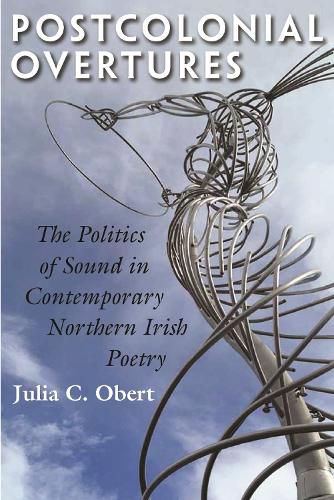Readings Newsletter
Become a Readings Member to make your shopping experience even easier.
Sign in or sign up for free!
You’re not far away from qualifying for FREE standard shipping within Australia
You’ve qualified for FREE standard shipping within Australia
The cart is loading…






Postcolonial Overtures explores the importance of sound in contemporary Northern Irish writing, focusing on the work of three canonical poets: Ciaran Carson, Derek Mahon, and Paul Muldoon. Obert argues that these poets respond to what Edward Said calls
geographical violence -to the stratification of the North’s visual spaces; to the sectarian symbols splashed across Belfast and beyond-by turning from the eye to the ear, tentatively remapping place in acoustic space. Carson, for instance, casts Troubles-era Belfast as a
demolition city,
its landmarks
swallowed in the maw of time and trouble,
and tries to compensate for this inhospitality by reimagining landscape as soundscape, an immersive auditory field.
This strategy suggests sound’s political and affective potential: music, accent, and even comfortingly familiar white noise can help subjects, otherwise unmoored, feel at home. Drawing on a diverse range of fields, Obert devotes two chapters to the examination of each poet’s work, allowing room for both in-depth formalist readings and contextual and theoretical understandings of the poems and their reverberating effects.
$9.00 standard shipping within Australia
FREE standard shipping within Australia for orders over $100.00
Express & International shipping calculated at checkout
Postcolonial Overtures explores the importance of sound in contemporary Northern Irish writing, focusing on the work of three canonical poets: Ciaran Carson, Derek Mahon, and Paul Muldoon. Obert argues that these poets respond to what Edward Said calls
geographical violence -to the stratification of the North’s visual spaces; to the sectarian symbols splashed across Belfast and beyond-by turning from the eye to the ear, tentatively remapping place in acoustic space. Carson, for instance, casts Troubles-era Belfast as a
demolition city,
its landmarks
swallowed in the maw of time and trouble,
and tries to compensate for this inhospitality by reimagining landscape as soundscape, an immersive auditory field.
This strategy suggests sound’s political and affective potential: music, accent, and even comfortingly familiar white noise can help subjects, otherwise unmoored, feel at home. Drawing on a diverse range of fields, Obert devotes two chapters to the examination of each poet’s work, allowing room for both in-depth formalist readings and contextual and theoretical understandings of the poems and their reverberating effects.